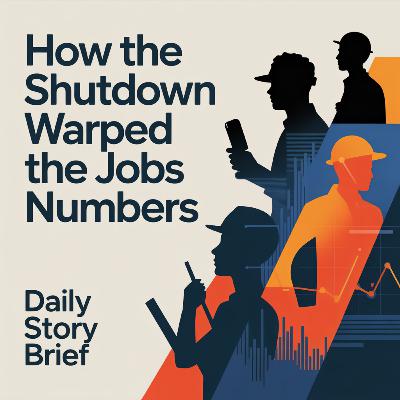How the Shutdown Warped the Jobs Numbers
Description
In this episode of Daily Story Brief, we walk straight into the heart of America’s economic “data fog” and unpack what might be the most important jobs report of the quarter—and the strangest. After a 43-day government shutdown that turned off the lights at the Bureau of Labor Statistics, the long-delayed September employment report finally lands on November 20th, just weeks before a make-or-break Federal Reserve meeting. The result is a tense, confusing snapshot of an economy that looks solid on the surface and deeply fragile underneath.
The hosts start with the headline surprise: U.S. employers added 119,000 jobs in September, more than double what many Wall Street forecasters expected. Against consensus estimates around 50,000, the number looks like a clear sign of resilience. But when you stack it against the boom years of the post-pandemic recovery, or even the 12-month average of 147,000 monthly gains earlier this year, it feels more like a slower, late-cycle grind than a roaring labor market. We break down where those jobs really came from—an economy leaning heavily on healthcare, social assistance, restaurants and bars, with construction and retail holding on while more trade-exposed sectors falter.
From there, the episode pulls apart the “good news” and shows the cracks. Wage growth is still running at 3.8% year over year, hotter than the 3.0–3.5% range many economists see as compatible with 2% inflation. At the same time, the labor force swelled by 470,000 people in September and participation climbed to its highest level since May, a sign that Americans are either feeling more optimistic about job prospects or more pressured to look for work. Yet that influx of job seekers pushed the unemployment rate up to 4.4%, its highest since 2021, and exposed worrying disparities—especially for Black women, whose jobless rate jumped sharply in a single month.
Then comes the real gut punch: revisions. The hosts walk you through how the BLS quietly rewrote the summer, taking what had looked like a weak but positive stretch and revealing something closer to stall speed. July is revised down, and August, once reported as a modest gain, is flipped into a net loss of 4,000 jobs—joining June as the second negative month of the year. Add in clear job losses in transportation, warehousing, manufacturing, federal government, and temporary help services, and the picture shifts from “soft landing” to “low hire, low fire limbo” where people who already have jobs feel stable, but those hunting for work face months of rejection.
The episode doesn’t leave this at the level of charts and acronyms. It connects the macro story to real lives: the avalanche of layoff announcements from corporate giants like Verizon, Amazon, Target, UPS, automakers and media companies, and the experience of job seekers sending hundreds of applications for a single interview. The hosts highlight how the average spell of unemployment has stretched to nearly six months, explaining why the labor market can look “fine” in the aggregate while feeling brutal on the ground.
All of this funnels into a high-stakes dilemma for the Federal Reserve’s December meeting. With no October jobs report at all and the combined October–November data delayed until after the decision, the Fed is effectively flying blind. Hawks point to the 119,000 payroll gain and elevated wages as reasons to hold rates steady and keep pressure on inflation. Doves point to the negative summer revisions, higher unemployment, layoffs and sectoral weakness as clear evidence the labor market is deteriorating and needs relief. Layered on top are four big structural forces—tariffs and trade uncertainty, AI-driven productivity, the lagged impact of high interest rates, and shrinking labor supply from immigration crackdowns and retirements.














